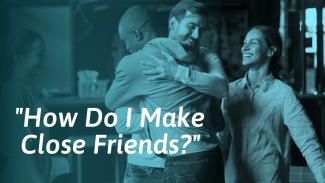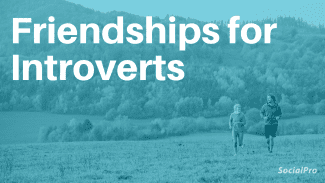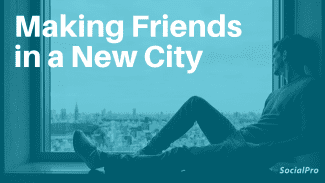Friendship comes in many forms, from casual acquaintances to best friends. In this article, you’ll learn about the 4 levels of friendship. We’ll also look at two stage-based psychological theories of friendship.
The 4 levels of friendship
It’s common to have lots of acquaintances, several casual friends, and only one or two close or intimate friends. Friendships require more time and effort to maintain, and research suggests that it’s difficult to hold on to more than 50 good friends at a time.[1]
Some people prefer casual friendships and loose ties. Some are only interested in spending time with close friends. Others like to have friends from all categories. However, research shows that it’s healthy to have a varied social circle that includes different types of friends.[2]
In general, non-romantic relationships fit into one of the following categories:
1. Acquaintances
These are people you recognize and who recognize you. You may chat to them occasionally, know some basic facts about them, and make small talk.
For example, if you are acquainted with your neighbor, you might know their full name and what kind of job they do. Or, if you have acquaintances at work, you might make small talk with them in the break room about your jobs.
Acquaintances are polite and friendly when they happen to meet, but they don’t make plans to see one another. For example, if you’ve met someone at the library on several occasions and chatted about books without making firm plans to see each other again, they would fall into the acquaintance category.
2. Casual friends
Casual friends enjoy one another’s company and usually make plans to meet up. Unlike acquaintances, casual friends go beyond shallow topics during conversations. They tend to go beneath the surface and share slightly more personal things.
For example, an acquaintance might tell you their job title and where they work. A casual friend might share that they don’t like their coworkers much and are thinking of looking for a new job. However, at this stage, you don’t share sensitive personal information or open up about delicate or controversial topics. For example, you probably wouldn’t tell a casual friend about your relationship problems.
This kind of friendship is usually based on a shared hobby, job, or situation. For example, perhaps you have a friend at work you eat lunch with a couple of times per week because they are fun to hang out with. Or maybe you’ve met someone you like at a hobby-based group and occasionally grab a coffee together and talk about your shared interest.
3. Close friends
At this level, two people feel and show meaningful affection and concern for one another. Compared to casual friends, close friends usually want to see each other more often and offer more emotional support.[3]
Here are some other common characteristics of close friendships:
- You both feel able to reach out to each other at any time; you are happy to help one another in times of need.
- You have a mutual sense of respect and appreciation.
- You both feel comfortable showing your true selves; neither of you feels a need to put on a “mask” or persona.
- You ask one another for advice because you have faith in each other’s judgment.
- You invite each other to important celebrations and events, such as birthdays, graduation parties, etc.
- You are slow to judge one another. You don’t always approve of each other’s choices or opinions, but you try to empathize and understand rather than criticize or condemn.
They may refer to themselves as “good friends.” Research shows it takes around 200 hours of quality contact time to build a close friendship.[4] If you see each other often—for example, if you live in the same college dorm—it’s possible to become close within a few weeks.[4]
4. Intimate friends
An intimate friendship is similar to a close friendship. Intimate friends trust, accept, and support one another. However, an intimate friendship involves an even deeper sense of connection. With an intimate friend, very few topics are off-limits; you might feel able to talk about anything and everything. The friendship feels safe and familiar. Another term for an intimate friend is “best friend.”
Theories of how friendships develop
Psychologists aren’t only interested in the different levels of friendship. They’re also interested in how people move between these levels. Let’s look at two theories that explore how friendships form.
The ABCDE model
Psychologist George Levinger put forward his ABCDE theory that maps out how relationships begin, change, and end.[5]
Originally, his theory was used to explain how romantic heterosexual relationships progress, but it’s also been applied to other types of relationships, including friendships and parent-child relationships.[6]
Here are the stages in the ABCDE model:[5]
- Acquaintance: At this stage, two people decide that, based on first impressions, they would like to get to know each other. There are several factors that determine how likely it is that two people will try to move the relationship forward. For example, people who spend more time together are more likely to move to the next stage.
- Buildup: Both people start opening up, trusting one another, and becoming more invested in the relationship. They may discover things they dislike about one another but still feel as though the friendship is worth pursuing.
- Continuation: The friendship is stable and takes on importance to both people. They are committed to maintaining their friendship. For example, they may hang out regularly and make an effort to catch up every few weeks.
- Deterioration: Not all relationships deteriorate. But when they do, it can be for several reasons, such as a general feeling of incompatibility or a major argument. The people involved open up less often and spend less time together. Sometimes it’s possible to come back from this stage and resolve issues. Some friendships deteriorate suddenly. Others gradually weaken.
- Ending: The friendship is over. The former friends are no longer in touch or spend time together.
Not every friendship will go through each stage. For example, you might decide that you like one of your acquaintances and hope to turn them into a friend. But after spending more time hanging out, it might become clear that they aren’t the sort of person you want in your life. For example, they may have strong political views you don’t agree with, or they might have some annoying habits that put you off.
Knapp and Vangelisti’s Relationship Model
Like Levinger’s model, Mark L. Knapp and Anita L. Vangelisti’s framework gives an insight into the psychology of relationships and how they change over time.
This model has two main phases, each containing 5 different stages:[7]
Coming together, which outlines how a relationship starts and builds.
Coming apart, which outlines how a relationship breaks down, weakens, or ends.
Here are the 5 stages that make up the “Coming together” phase:
- Initiating: Two people try to make a positive first impression. For example, they might smile, introduce themselves, and make polite remarks. Both parties make it clear that they are open to interacting.
- Experimenting: The people involved decide whether they like each other enough to try building a relationship. This usually involves swapping basic or “safe” information, such as hobbies, job titles, and the kind of music, TV shows, and movies they enjoy.
- Intensifying: Having decided to grow their friendship, both people start opening up, sharing more personal information, building trust, and making an effort to spend time together. For example, one friend may invite another over for dinner.
- Integrating: At this point, the friends become a significant part of each other’s lives. For example, they might go on vacation together and merge their social groups.
- Bonding: This stage involves a public declaration or formal bonding ritual, such as marriage or a civil partnership. This stage usually applies only to romantic relationships.
Here are the 5 stages that make up the “Coming apart” phase:
- Differentiating: The friends shift their focus. Instead of concentrating on the things they have in common, they start focusing on the things that make them different. As a result, they may feel less close. For example, one of the friends might feel that because their friend has started a family, they can’t relate to them much anymore and start to put more energy into new friendships with other parents.
- Circumscribing: One or both friends start setting boundaries and limits that push them even further apart. For example, they may start saying things like, “Oh, I don’t want to bother you with my problems” or “I don’t want to bore you by talking about my children.”
- Stagnating: The friendship feels stale and less satisfying. Both parties may feel that their relationship has become distant. Talking or hanging out might be awkward. Even if they try, the friends can’t seem to resolve their differences.
- Avoiding: As it becomes clear that the friendship is no longer working, both people start to avoid one another. For example, they may be slow to respond to one another’s messages.
- Terminating: The friendship is over, and the friends are no longer in contact.
Common questions
How can you tell if someone is a fake friend?
A fake friend does not have your best interests at heart. They are not interested in building a healthy friendship based on mutual respect and trust. Common signs of a fake friend include flakiness, passive aggression, and an inability to be happy for you when things are going well in your life.
How long does the average friendship last?
It depends on many factors, including the depth of a friendship and how committed each person is to the relationship. However, research suggests that we lose 50% of our social circle every 7 years.[8]
What is the best type of friendship?
A friendship of any type can enrich your life. For example, acquaintances can help you expand your professional networks,[9] whereas close friends can offer emotional support. For most people, it’s best to have a variety of friendships.
What is a romantic friendship?
Romantic friendships, or “passionate friendships,” are very close, emotionally intense, and affectionate, but they are not sexual.[10] For example, romantic friends may hold hands and share a bed when staying over at each other’s home. However, they would not consider themselves a couple.








No love
This was a great article. Does it work the same way in families? Or is there a difference because in the beginning, birth sometimes has deep connections in place. But what if over time Family just drifts away the same way friendship does and the ties that bind are broken forever?
lol girl this was the best thing I’ve ever read